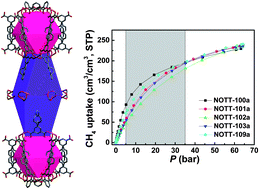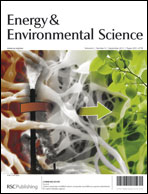A series of metal–organic frameworks (NOTT-100a (MOF-505a), NOTT-101a, NOTT-102a, NOTT-103a and NOTT-109a) with variable open copper sites and micropore spaces have been examined as potential adsorbents for methane storage. They exhibit high adsorption capacities for methane at 300 K and 35 bar (181–196 cm3 (STP) cm−3). Supposing that the deliverable amount of methane is defined as the difference in the amount of methane adsorbed between 5 bar and 35 bar, NOTT-101a, NOTT-102a and NOTT-103a exhibit excellent deliverable capacities of methane (136–140 cm3 (STP) cm−3), comparable to the highest of all previously reported MOF materials. The gravimetric methane uptake in this MOF series systematically increases with increasing porosity, while their methane storage pore occupancy decreases with increasing pore size. The fact that gravimetric methane uptakes correlate well with their corresponding pore volumes enables us to derive an empirical equation: C = −126.69 × Vp2 + 381.62 × Vp − 12.57, where C is the excess gravimetric methane storage capacity at 35 bar and 300 K in cm3 (STP) g−1, and Vp is the pore volume of a MOF material in cm3 g−1. This empirical equation can predict the methane storage performance of previously reported microporous MOF materials of Vp less than 1.50 cm3 g−1 reasonably well, and thus provides a convenient method to screen MOFs for methane storage purposes.

You have access to this article
 Please wait while we load your content...
Something went wrong. Try again?
Please wait while we load your content...
Something went wrong. Try again?


 Please wait while we load your content...
Please wait while we load your content...